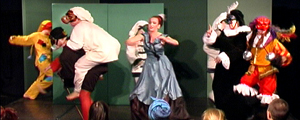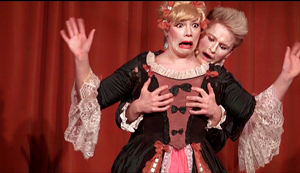The acting style in Commedia dell’Arte is very crude and rough, especially in early Commedia dell’Arte. The masks can be tremendously grotesque; the plots plain vulgar; situations – burlesque. Over time Commedia dell’Arte got more refined, soon it had become quit suitable for the salons and by the middle of the eighteenth century it was so refined that it died out. Off course it was not the only reason for it to die, but Commedia dell’Arte is depending on its crudeness to maintain its nature.
This is naturally an acting style that was “in fashion” in the renaissance and the early baroque eras, but must also remember that Commedia dell’Arte has its roots in the carnival and the market, and the language of the market squares was bigger, louder and wilder than in ordinary life. When we talk about an acting style “in fashion” we must have in mind that at the time Europe was not yet over civilized. The Victorian ideals have not yet been spread in Europe. Since people lived so close upon each other things like physical defects, human odors, excrement, sex, farts, spit and sweat were part of everyday life. Just as we probably would feel physically ill being in a street scene from the renaissance, someone from the renaissance would probably see a western city of today as a clinical hell.
So even if the grotesque style of acting in Commedia dell’Arte was the style of the time and a part of normality it has gotten other meanings today. (See The Story in Commedia dell’Arte) With its crudeness, wildness, brutality, untamed sexuality Commedia dell’Arte elucidates suppressed desires and expresses psychological truths that we otherwise has no place to laugh at. If we avoid these truths Commedia dell’Arte would become meaningless and boring. It would give a colorless and false picture of the world.
A very common reaction on Commedia dell’Arte is that it is too crude, too grotesque, that the vulgar in the shows are too obvious. From different directions we are asked for circumlocutions and hypocritical moderations instead of simplicity and clarity. But Commedia dell’Arte does always express itself “straight on” without decorations or idealization.
Commedia dell’Arte neither does nor demand any special intelligence or greater sensitivity then common folks from its audiences. It doesn’t even work if we first have to interpret or analyze before we can understand it – it is direct laughter. It seems as if there requires some sort of extra degree of unintelligibility for a work to be seen as “fine culture”, as if laughter was a less deep emotion. This is a part of the discussion about literary theatre versus physical theater and vulgar comedy In general.



Pingback: The Grotesque! Contemplation – Critical Research Journal, Photography MA
Pingback: Stage strategies (Part 2) |